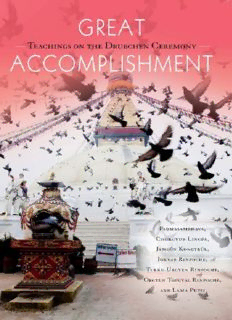
Great Accomplishment PDF
Preview Great Accomplishment
R Y B • ANGJUNG ESHE OOKS .RANGJUNG.COM WWW PADMASAMBHAVA • Treasures from Juniper Ridge • Advice from the Lotus- Born • Dakini Teachings PADMASAMBHAVA AND JAMGÖN KONGTRÜL • The Light of Wisdom, Vol. 1, Vol. 2, Vol. 3, Vol. 4, & Vol. 5 YESHE TSOGYAL • The Lotus-Born DAKPO TASHI NAMGYAL • Clarifying the Natural State TSELE NATSOK RANGDRÖL • Mirror of Mindfulness • Empowerment • Heart Lamp CHOKGYUR LINGPA • Ocean of Amrita •The Great Gate •Skillful Grace TRAKTUNG DUDJOM LINGPA • A Clear Mirror JAMGÖN MIPHAM RINPOCHE • Gateway to Knowledge, Vol. 1, Vol. 2, Vol. 3, & Vol. 4 TULKU URGYEN RINPOCHE • Blazing Splendor • Rainbow Painting • As It Is, Vol. 1 & Vol. 2 • Vajra Speech • Repeating the Words of the Buddha ADEU RINPOCHE • Freedom in Bondage KHENCHEN THRANGU RINPOCHE • King of Samadhi CHÖKYI NYIMA RINPOCHE • Present Fresh Wakefulness TULKU THONDUP • Enlightened Living ORGYEN TOBGYAL RINPOCHE • Life & Teachings of Chokgyur Lingpa DZIGAR KONGTRÜL RINPOCHE • Uncommon Happiness TSOKNYI RINPOCHE • Fearless Simplicity • Carefree Dignity DZOGCHEN TRILOGY COMPILED BY MARCIA BINDER SCHMIDT • Dzogchen Primer • Dzogchen Essentials • Quintessential Dzogchen ERIK PEMA KUNSANG • Wellsprings of the Great Perfection • A Tibetan Buddhist Companion • The Rangjung Yeshe Tibetan-English Dictionary of Buddhist Culture & Perfect Clarity MARCIA DECHEN WANGMO • Confessions of a Gypsy Yogini RANGJUNG YESHE PUBLICATIONS Flat 5a, Greenview Garden, 125 Robinson Road, Hong Kong ADDRESS LETTERS TO: Rangjung Yeshe Publications Ka-Nying Shedrub Ling Monastery P.O. Box 1200, Kathmandu, Nepal www.rangjung.com Copyright © 2013 Rangjung Yeshe Publications All rights reserved. No part of this book may be reproduced in any form or by any means, electronic or mechanical, including photocopying, recording or by any information storage and retrieval system, without written permission from the publisher FIRST PAPERBACK EDITION PUBLISHED IN 2013 Distributed to the book trade by: North Atlantic Books & Random House, Inc. eISBN: 978-962-7341-83-3 Ocean of Amrita. Light of Wisdom, Vol. III, Padmasambhava, Chokgyur Lingpa, Jamyang Khyentse Wangpo, Jamgön Kongtrül & Joykyab Rinpoche Translated from the Tibetan based on the teachings of Kyabje Tulku Urgyen Rinpoche by Erik Pema Kunsang (Erik Hein Schmidt) with Gyurme Avertin. Edited by Michael Tweed and Marcia Binder Schmidt. Photo courtesy of Oscar Fernandez v3.1 CONTENTS Cover Title Page Copyright PREFACE Marcia Dechen Wangmo INTRODUCTORY TEACHINGS Tulku Urgyen Rinpoche THE LIGHT OF WISDOM PART III THE PATH OF ACCOMPLISHING Padmasambhava COMMENTARY Jamgön Kongtrül NOTES TO SECTION I Jokyab Rinpoche DRUBCHEN ARRANGEMENT AND OVERVIEW Orgyen Topgyal Rinpoche DRUBCHEN Lama Putse, Pema Tashi INTRODUCTION THE EXCELLENT PREPARATION OF BODHICHITTA ACCUMULATION OF MERIT: THE SEVEN BRANCHES THE BODHICHITTA OF APPLICATION: THE FOUR IMMEASURABLES BUDDHA NATURE THE MAIN PART MANTRA RECITATION THE SPECIAL MANDALA OF THE PEACEFUL AND WRATHFUL ONES DISSOLVING DUALITY CHANTING MENDING PURIFYING FEAST OPENING THE EYES ACKNOWLEDGING THE PURITY SOWING THE SEEDS CONCLUDING RITUAL RECEIVING THE SIDDHIS Appendixes APPENDIX 1 APPENDIX 2 NOTES TO SECTION 2 PREFACE Marcia Dechen Wangmo Preferring to practice alone, I have always found it difficult to engage in the annual drubchen practices at the monasteries in Nepal. To me, there was just too much color, noise, and people jostling for position and blessings. Moreover, in the monasteries in Nepal, a temporarily more important or wealthy sponsor always squeezed us Westerners out of our seats, even if we had diligently come to practice every day. So, in the midst of the sublime mandala, destructive emotions abounded in my small mind, and I decided it was better to practice alone on the mountainside and avoid all the squabbling, pressure, and complications. I love sadhanas and practice them daily, so my inability to handle my reactions was a bit of a contradiction, especially in that I considered myself to be a decent meditator. So why did I react differently whether in a crowd or in solitude? My mind is in both places, and if I cannot control it in a group, a religious one at that, then what is the point of identifying oneself as a practitioner at all? I have seen many great Dzogchen meditators, like Kyabje Dilgo Khyentse Rinpoche, preside over many drubchens, unmoved from rigpa, so I did have a clear example of how one could practice. In any event, for many years I opted to stay away from such public rituals and practice on my own instead. All of that changed when I started to be in the company of Orgyen Topgyal Rinpoche, to work on completing the Light of Wisdom1 series and the Tukdrub drubchen text, and begin to really learn what drubchen was all about. Suddenly, what previously seemed a burden was a great joy and I began to travel around the world to participate in drubchens. Of course, I always appreciated interacting with sublime beings in the development stage practices, but now I was having a really good time doing it, aside from the sheer exhaustion and complete sensory overload. It started with a comment by Dzongsar Khyentse Rinpoche about his friend Orgyen Topgyal, where he quoted him saying, “The Vajrayana path is basically achieving enlightenment while having fun.” My appreciation was also nurtured by performing drubchens at the Rigpa Centers in the West, where order and discipline was the code of behavior, and no wild people or self-important individuals could unseat me. So, in a way, the environment was protected. I certainly did not need to fear for my life with people pushing and stampeding for
Description: